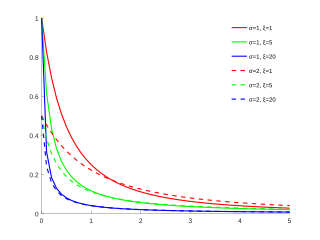Closed-form formulas exist for calculating TVaR when the payoff of a portfolio  or a corresponding loss
or a corresponding loss  follows a specific continuous distribution. If
follows a specific continuous distribution. If  follows some probability distribution with the probability density function (p.d.f.)
follows some probability distribution with the probability density function (p.d.f.)  and the cumulative distribution function (c.d.f.)
and the cumulative distribution function (c.d.f.)  , the left-tail TVaR can be represented as
, the left-tail TVaR can be represented as

For engineering or actuarial applications it is more common to consider the distribution of losses  , in this case the right-tail TVaR is considered (typically for
, in this case the right-tail TVaR is considered (typically for  95% or 99%):
95% or 99%):

Since some formulas below were derived for the left-tail case and some for the right-tail case, the following reconciliations can be useful:

and

Logistic distribution
If the payoff of a portfolio  follows logistic distribution with the p.d.f.
follows logistic distribution with the p.d.f.

and the c.d.f.

then the left-tail TVaR is equal to [9]

If the loss of a portfolio  follows logistic distribution, the right-tail TVaR is equal to [10]
follows logistic distribution, the right-tail TVaR is equal to [10]

Exponential distribution
If the loss of a portfolio  follows exponential distribution with the p.d.f.
follows exponential distribution with the p.d.f.

and the c.d.f.

then the right-tail TVaR is equal to [10]

Pareto distribution
If the loss of a portfolio  follows Pareto distribution with the p.d.f.
follows Pareto distribution with the p.d.f.

and the c.d.f.

then the right-tail TVaR is equal to [10]

Generalized Pareto distribution (GPD)
If the loss of a portfolio  follows GPD with the p.d.f.
follows GPD with the p.d.f.

and the c.d.f.

then the right-tail TVaR is equal to

and the VaR is equal to [10]

Weibull distribution
If the loss of a portfolio  follows Weibull distribution with the p.d.f.
follows Weibull distribution with the p.d.f.

and the c.d.f.

then the right-tail TVaR is equal to

where  is the upper incomplete gamma function. [10]
is the upper incomplete gamma function. [10]
Generalized extreme value distribution (GEV)
If the payoff of a portfolio  follows GEV with the p.d.f.
follows GEV with the p.d.f.

and the c.d.f.

then the left-tail TVaR is equal to

and the VaR is equal to

where  is the upper incomplete gamma function,
is the upper incomplete gamma function,  is the logarithmic integral function. [11] If the loss of a portfolio
is the logarithmic integral function. [11] If the loss of a portfolio  follows GEV, then the right-tail TVaR is equal to
follows GEV, then the right-tail TVaR is equal to

where  is the lower incomplete gamma function,
is the lower incomplete gamma function,  is the Euler-Mascheroni constant. [10]
is the Euler-Mascheroni constant. [10]
Generalized hyperbolic secant (GHS) distribution
If the payoff of a portfolio  follows GHS distribution with the p.d.f.
follows GHS distribution with the p.d.f.

and the c.d.f.

then the left-tail TVaR is equal to

where  is the Spence's function,
is the Spence's function,  is the imaginary unit. [11]
is the imaginary unit. [11]
Johnson's SU-distribution
If the payoff of a portfolio  follows Johnson's SU-distribution with the c.d.f.
follows Johnson's SU-distribution with the c.d.f.

then the left-tail TVaR is equal to

where  is the c.d.f. of the standard normal distribution. [12]
is the c.d.f. of the standard normal distribution. [12]
Burr type XII distribution
If the payoff of a portfolio  follows the Burr type XII distribution with the p.d.f.
follows the Burr type XII distribution with the p.d.f.

and the c.d.f.

the left-tail TVaR is equal to

where  is the hypergeometric function. Alternatively, [11]
is the hypergeometric function. Alternatively, [11]

Dagum distribution
If the payoff of a portfolio  follows the Dagum distribution with the p.d.f.
follows the Dagum distribution with the p.d.f.

and the c.d.f.

the left-tail TVaR is equal to

where  is the hypergeometric function. [11]
is the hypergeometric function. [11]
Log-logistic distribution
If the payoff of a portfolio  follows log-logistic distribution, i.e. the random variable
follows log-logistic distribution, i.e. the random variable  follows logistic distribution with the p.d.f.
follows logistic distribution with the p.d.f.

then the left-tail TVaR is equal to

where  is the regularized incomplete beta function,
is the regularized incomplete beta function,  . As the incomplete beta function is defined only for positive arguments, for a more generic case the left-tail TVaR can be expressed with the hypergeometric function: [13]
. As the incomplete beta function is defined only for positive arguments, for a more generic case the left-tail TVaR can be expressed with the hypergeometric function: [13]

If the loss of a portfolio  follows log-logistic distribution with p.d.f.
follows log-logistic distribution with p.d.f.

and c.d.f.

then the right-tail TVaR is equal to

where  is the incomplete beta function. [10]
is the incomplete beta function. [10]




































































































